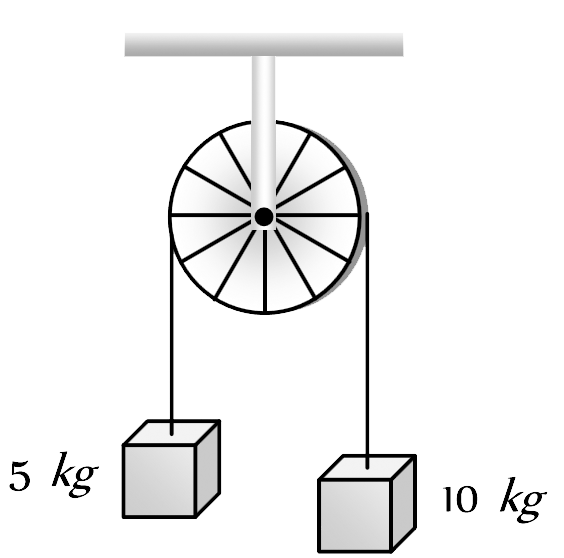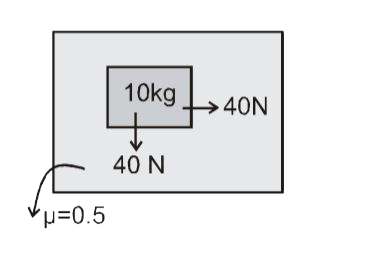The fricition coefficient between the table and block shown in fig. is 0.2 find the acceleration of the system (Take g=10m/s2)
 Solution in Gujrati
Solution in Gujrati
For three blocks the equations of motion are-
a=15g−5g−g25=(9g25)
15g−T1=15a⇒T1=15g−135g25=375g−135g25=96N
T2−5g=5(9g25)⇒T2=5g+9g5=34g5=68N
Topper's Solved these Questions
- NEWTONS LAWS OF MOTIONBOOK - ALLEN CHAPTER - NEWTONS LAWS OF MOTIONEXERCISE - EXERCISE-I
52 Videos
- NEWTONS LAWS OF MOTIONBOOK - ALLEN CHAPTER - NEWTONS LAWS OF MOTIONEXERCISE - EXERCISE-II
112 Videos
- NEWTONS LAWS OF MOTIONBOOK - ALLEN CHAPTER - NEWTONS LAWS OF MOTIONEXERCISE - EXERCISE-III
28 Videos
- NEWTON'S LAWS OF MOTION & FRICTIONBOOK - ALLEN CHAPTER - NEWTON'S LAWS OF MOTION & FRICTIONEXERCISE - EXERCISE (JA)
4 Videos
- RACEBOOK - ALLEN CHAPTER - RACEEXERCISE - Basic Maths (Wave Motion & Dopplers Effect) (Stationary waves & doppler effect, beats)
25 Videos
Similar Questions
USS 150) Two masses of 5 kg and 10 kg are connected to a pulley as shown. What will be the acceleration of the system (g= acceleration due to gravity)

View SolutionA particle is in straight line motion with uniform velocity A force is not required
View SolutionAssertion: The driver in a vechicle moving with a constant speed on a straight road is in a non-inertial frame of referance.
Reason: A reference frame in which Newton's laws of motion are applicable is non-inertial.
View SolutionA piece of wire is bent in the shape of a parabola y=kx2 (y-axis vertical) with a bead of mass m on it. The bead can slide on the wire without friction. It stays at the lowest point of the parabola when the wire is at rest. The wire is now accelerated parallel to the x-axis with a constant acceleration a. The distance of the new equilibrium position of the bead, where the bead can stay at rest with respect to the wire, from the y-axis is:
View SolutionThe frequency of a radar is 780 MHz. After getting reflected from an approaching aeroplane, the apparent frequency is more than the actual frequency by 2.6 kHz. The aeroplane has a speed of
View Solutiona block is kept on the floor of an elevator at rest. The elevator starts descending with an acceleration of 12ms2. Find the displacement of the block during the first 0.2 s after the start. Take g=10ms2.
View SolutionA block A with mass 100kg is resting on another block B of mass 200kg. As shown in figure a horizontal rope tied to a wall hold it. The coefficient of friction between A and B is 0.2 while coefficient of friction between B and the ground is 0.3 . the minimum required force F to start moving B will be.

View SolutionA horizontal force of 10N is necessary to just hold a block stationary against a wall. The coefficient of fricition between the block and the wall is 0.2 then find the weight of the block. (g=10m//s^(2))
View SolutionConsider the system shown in the figure. Coefficient of friction between the block and table is μ=0.5. The system is released from rest. Find the work done by friction, when the speed of block is 10 m/s (m=1kg)

View SolutionTop view of a block on a table is shown (g=10m/s2)

Find out the acceleration of the block.
View SolutionConsider a system of two masses and a pulley shown in the figure. The coefficient of friction between the two blocks and also between block and table is 0.1. Find the force F, that must be given to the 0.8 kg block such that it attains acceleration of 5 m//s^(2) . (Assume, acceleration due to gravity, g=10 m//s^(2) )
View SolutionWhen the three blocks of masses M, 2M and 2M in the system are released from rest, they accelerate with a magnitude of 1 m/ s^(2) . What is the coefficient of kinetic friction between block on the table and the table top? (neglect the force of friction in the pulleys and take g =10 m/ s^(2) )
View SolutionWhat is the acceleration of the block and trolley system shown in a Fig.(a), if the coefficient of kinetic friction between the trolley and the surface is 0.04? What is the tension in the string? (Take g =10ms−2 ). Neglect the mass of the string.

View SolutionWhat is the acceleration of the block and trolley system shown in a Fig.(a), if the coefficient of kinetic friction between the trolley and the surface is 0.04? What is the tension in the string? (Take g =10ms−2 ). Neglect the mass of the string.

View SolutionWhat is the acceleration of the block and trolley system shown in a Fig.(a), if the coefficient of kinetic friction between the trolley and the surface is 0.04? What is the tension in the string? (Take g =10ms−2 ). Neglect the mass of the string.

View SolutionA block is kept on the floor of an elevator at rest. The elevator starts descending with an acceleration of 12m/s2. Find the displacement of the block during the first 0.2 s after the start. Take g=10m/s2
View Solution
